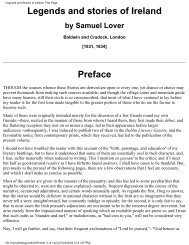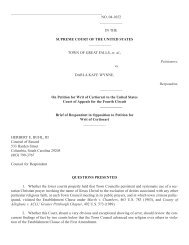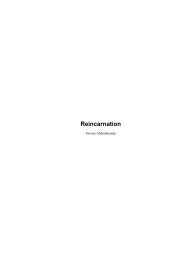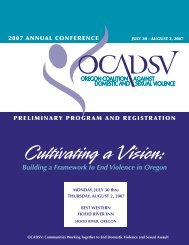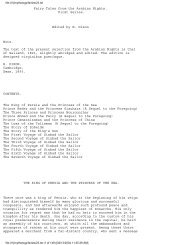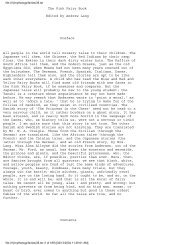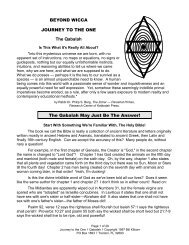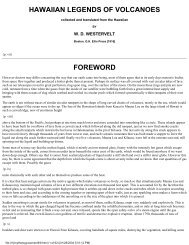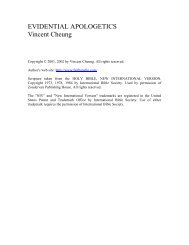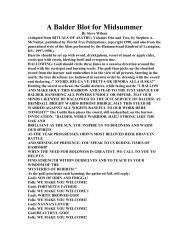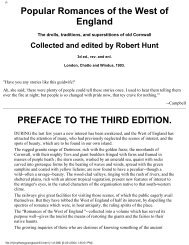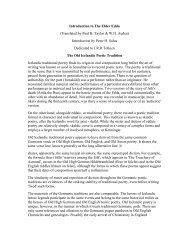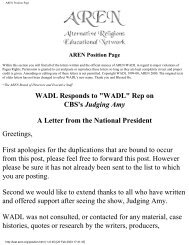Tales and Traditions of the Eskimo - Alternative Religions ...
Tales and Traditions of the Eskimo - Alternative Religions ...
Tales and Traditions of the Eskimo - Alternative Religions ...
Create successful ePaper yourself
Turn your PDF publications into a flip-book with our unique Google optimized e-Paper software.
<strong>Tales</strong> <strong>and</strong> <strong>Traditions</strong> <strong>of</strong> <strong>the</strong> <strong>Eskimo</strong> - Title Page<br />
accordance with what will be explained in <strong>the</strong> following introduction, we likewise suppose <strong>the</strong> principal<br />
part <strong>of</strong> <strong>the</strong> folk-lore to have originated about this period, <strong>the</strong> subjects mentioned in <strong>the</strong> tales would<br />
constitute a means for guiding us in search <strong>of</strong> <strong>the</strong> locality where <strong>the</strong> first settling on <strong>the</strong> sea-shore is<br />
likely to have taken place. For this purpose it will be sufficient to call to mind <strong>the</strong> tales treating <strong>of</strong> <strong>the</strong><br />
following subjects:<br />
1. An expedition to <strong>the</strong> inl<strong>and</strong>ers for <strong>the</strong> purpose <strong>of</strong> procuring metal knives.<br />
2. A man descended both from <strong>the</strong> coast people <strong>and</strong> <strong>the</strong> inl<strong>and</strong>ers, <strong>and</strong> his deeds among both.<br />
3. The bro<strong>the</strong>rs visiting <strong>the</strong>ir sister, who had been married into a tribe <strong>of</strong> cannibals.<br />
4. An onslaught on <strong>the</strong> coast people, from which only a couple <strong>of</strong> children were saved, who went <strong>of</strong>f<br />
roaming far <strong>and</strong> wide, <strong>and</strong> performed great deeds.<br />
5. A woman living alternately among <strong>the</strong> coast people <strong>and</strong> <strong>the</strong> inl<strong>and</strong>ers, persuading <strong>the</strong>m to wage war<br />
against each o<strong>the</strong>r.<br />
6. Women who from different causes went <strong>and</strong> settled down among <strong>the</strong> inl<strong>and</strong>ers.<br />
7. A man taming wild animals for <strong>the</strong> purpose <strong>of</strong> crossing <strong>the</strong> frozen sea.<br />
8. Different travels to Akilinek.<br />
On comparing <strong>the</strong>se subjects <strong>of</strong> <strong>the</strong> tales with <strong>the</strong> present geographical conditions, we will find that in all<br />
respects <strong>the</strong>y suggest America <strong>and</strong> not Asia. The probable identity <strong>of</strong> <strong>the</strong> "inl<strong>and</strong>ers" with <strong>the</strong> Indians has<br />
already been remarked on. When <strong>the</strong> new coast people began to spread along <strong>the</strong> Arctic shores, some<br />
b<strong>and</strong>s <strong>of</strong> <strong>the</strong>m may very probably have crossed Behring Strait p. 73 <strong>and</strong> settled on <strong>the</strong> opposite shore,<br />
which is perhaps identical with <strong>the</strong> fabulous country <strong>of</strong> Akilinek. On <strong>the</strong> o<strong>the</strong>r h<strong>and</strong>, <strong>the</strong>re is very little<br />
probability that a people can have moved from interior Asia to settle on its polar sea-shore, at <strong>the</strong> same<br />
time turning <strong>Eskimo</strong>, <strong>and</strong> afterwards almost wholly emigrated to America.<br />
On comparing <strong>the</strong> <strong>Eskimo</strong> with <strong>the</strong> neighbouring nations, <strong>the</strong>ir physical complexion certainly seems to<br />
point at an Asiatic origin; but, as far as we know, <strong>the</strong> latest investigations have also shown a transitional<br />
link to exist between <strong>the</strong> <strong>Eskimo</strong> <strong>and</strong> <strong>the</strong> o<strong>the</strong>r American nations, which would sufficiently indicate <strong>the</strong><br />
possibility <strong>of</strong> a common origin from <strong>the</strong> same continent. As to <strong>the</strong>ir mode <strong>of</strong> life, <strong>the</strong> <strong>Eskimo</strong> decidedly<br />
resemble <strong>the</strong>ir American neighbours; whereas all <strong>the</strong> nor<strong>the</strong>rnmost nations <strong>of</strong> <strong>the</strong> Old World, with <strong>the</strong><br />
exception <strong>of</strong> <strong>the</strong> Kamtskadales, are pastoral tribes, regarding fishing on <strong>the</strong>ir rivers as only a secondary<br />
occupation; <strong>and</strong> when some <strong>of</strong> <strong>the</strong>m have settled on <strong>the</strong> river-sides, or even on <strong>the</strong> sea-shore, given up<br />
<strong>the</strong>ir reindeer, <strong>and</strong> made fishing <strong>and</strong> hunting <strong>the</strong>ir main means <strong>of</strong> subsistence, <strong>the</strong>se have still been<br />
families originally belonging to <strong>the</strong> pastoral tribes, who have changed <strong>the</strong>ir mode <strong>of</strong> life chiefly on<br />
account <strong>of</strong> poverty. In <strong>the</strong> Old World we nowhere find anything at all like a coast race as opposed to an<br />
inl<strong>and</strong> people, with <strong>the</strong> exception <strong>of</strong> <strong>the</strong> Asiatic <strong>Eskimo</strong> or <strong>the</strong> Coast-Tschoukschees, who are quite<br />
different from, but still live in friendly relations with, <strong>the</strong> pastoral Tschoukschees. As to religion, <strong>the</strong><br />
<strong>Eskimo</strong> are also allied to <strong>the</strong> Americans, <strong>and</strong> differ from <strong>the</strong> Asiatic nations, who have a more perfect<br />
system <strong>of</strong> deities, worship idols, <strong>and</strong> with whom sacrifices form <strong>the</strong> principal part <strong>of</strong> <strong>the</strong>ir religious rites.<br />
With regard to <strong>the</strong>ir language, <strong>the</strong> <strong>Eskimo</strong> also appear akin to <strong>the</strong> American nations in regard to its<br />
decidedly polysyn<strong>the</strong>tic structure. Here, however, on <strong>the</strong> o<strong>the</strong>r h<strong>and</strong>, we meet with some very remarkable<br />
similarities between <strong>the</strong> <strong>Eskimo</strong> idiom <strong>and</strong> p. 74 <strong>the</strong> language <strong>of</strong> Siberia, belonging to <strong>the</strong> Altaic or Finnish<br />
file:///I|/mythology/american indian/24/24.html (48 <strong>of</strong> 317) [01/24/2004 8:57:49 AM]



